Shore & Excursions
Naples and Amalfi Coast | Civitavecchia and Rome | Livorno
Shore Excursions from the port of Naples.
The bay of Naples, a wonderful climate, spectacular sea, and dramatically beautiful views, all created by nature, to be subsequently imprinted by the ancient civilisations which have passed through the gulf leaving behind them the traces of their art and architecture and infusing the area with aspects of their traditions and culture. The Bay of Naples is, in fact, one of the richest areas for archaeological, artistic, and monumental works, as well as being a land of great popular traditions, renowned for the warmth of the people and their passion for music, dance, and the dramatic arts. From small, almost unknown, villages to the vibrant city of Naples and the colourful towns of Sorrento and Pompei, the bay forms a magnificent display of unique and unforgettable panoramas, a continuum of past history and culture - with its churches, cloisters and monuments and popular traditions. The same beauty of the mainland can be found across the water on the three small islands of the gulf, the tiny Procida, the green Ischia, and the supreme queen of the gulf, Capri. All places to see, each one to explore and, whenever possible, to experience to the full.
You will be met at the Port of Naples, by our driver/guide for your day tour to the Amalfi Coast. Along the way you will be given by our driver/guide arrangement of the itinerary to stop, and information of the most important sights to visit during your exciting day in Naples, the service is driver/guided and is individually personalized.
Naples and Amalfi Coast | Civitavecchia and Rome | Livorno
Shore Excursions from the port of Naples.
The bay of Naples, a wonderful climate, spectacular sea, and dramatically beautiful views, all created by nature, to be subsequently imprinted by the ancient civilisations which have passed through the gulf leaving behind them the traces of their art and architecture and infusing the area with aspects of their traditions and culture. The Bay of Naples is, in fact, one of the richest areas for archaeological, artistic, and monumental works, as well as being a land of great popular traditions, renowned for the warmth of the people and their passion for music, dance, and the dramatic arts. From small, almost unknown, villages to the vibrant city of Naples and the colourful towns of Sorrento and Pompei, the bay forms a magnificent display of unique and unforgettable panoramas, a continuum of past history and culture - with its churches, cloisters and monuments and popular traditions. The same beauty of the mainland can be found across the water on the three small islands of the gulf, the tiny Procida, the green Ischia, and the supreme queen of the gulf, Capri. All places to see, each one to explore and, whenever possible, to experience to the full.
You will be met at the Port of Naples, by our driver/guide for your day tour to the Amalfi Coast. Along the way you will be given by our driver/guide arrangement of the itinerary to stop, and information of the most important sights to visit during your exciting day in Naples, the service is driver/guided and is individually personalized.
| Ravello: Between the Valley del Dragone and the Valley della Regina, up a supremely panoramic narrow road, which twists up from the coast towards the mountains, one finds Ravello. Its dominating position on the hill top offers the tourist a spectacular view over the whole of the Amalfi Coast. The tranquility of the town greatly appealed to poets and writers and international jet set. The wealth of art works in Ravello is preserved in numerous ecclesiastical buildings such as the Cathedral of St Pantaleone, Patron saint of the town, a building which is striking because of its marble work; the adjacent bell tower, the Church of St Martino, the Church of St Angelo and the Church of St Giovanni del Toro. The heart of Ravello is the Piazza Vescovado, with the Castle ruins, the Cathedral and Palazzo Rufolo. Villa Rufolo should not be missed, a building which is home to much of the art of Ravello and surrounded by splendid gardens, where numerous musical and cultural events are held. Villa Cimbrone is also well worth a visit. |
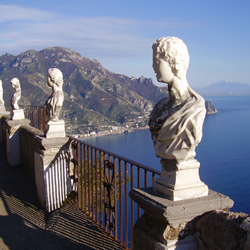 |
| Amalfi: Legend has it that Hercules fell in love with a nymph called Amalfi, a love which was cruelly ended by her death. The nymph was then buried in this, the most beautiful place in the world, and the city which was built here was named after her. It is not by chance that Amalfi, an ancient maritime Republic, is the heart of this stretch of coast, the famous Amalfi Coast, an International tourist destination, attracting those lured by its uniquely colored sea. The town hosts many traditional celebrations and events, including the descent of the comet from Monte Tabor, the Festa of St. Giuseppe, the Festa of St. Antonio, the historic sailing regatta contested by the four maritime republics, the lemon fair, St.Andrea patron saint of Amalfi, the underwater procession to the Grotta dello Smeraldo held at Christmas, the firework display of New Year's Eve and the traditional Via Crucis. To see: the Church of St Antonio, the Convent of St Francesco, the Paper Museum, the Chapel of St. Giuseppe del Castrista and the sumptuous Amalfi Cathedral. The most important of the town's craft traditions is that of paper making, which began in the 1700's. |
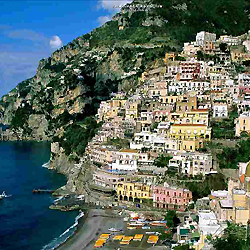 |
| Pompei: Inhabited since ancient times, the first traces of a fully established human settlement date back to the seventh century B.C, when Pompei was used as a strategic commercial centre by the Etruscan and Greek populations who chose the location for its opening on to the sea. The world wide fame of Pompei is, without the shadow of a doubt, linked to the eruption of the Vesuvius of August 29th of 79 A.D. which completely buried the city and the neighbouring towns of Herculaneum and Stabia. The hidden town was discovered by pure chance in 1594 by the Architect Domenico Fontana during the making of a trench. Excavations were initiated in 1748 by Carlo di Borbone whilst in the more recent past digs were supervised by Amedeo Maiuri in 1924 and by De Franciscis for those of 1961 which resulted in the uncovering of three fifths of the entire city. To visit whilst in Pompei, in addition to the archaeological site: the Amphitheatre, the House of Vettii, the House of Faun, the House of the Silver Wedding, the House of Menander, the Sanctuary of Pompei, the Basilica, the Museum of the Papal Sanctuary of Pompei, the Vesuvian Museum G.B. Alfano, the Temple of Apollo and the Villa of the Mysteries |
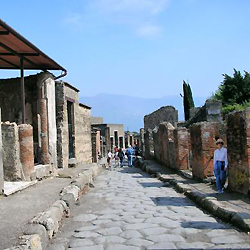 |
| Positano: Position is unique: stacked vertically on the slopes of the Lattari mountains. Sheltered by mounts Comune, Santa Maria a Castello, Sant'Angelo dei Pizzi, Paipo, Canocchia and Campo dei Galli, Positano has an enviably mild climate which makes it a perfect seaside resort. There are panoramic views across the water towards the islets of Li Galli, known also as the "Sirenuse". It was on these three islets, the Gallo Lungo, Castellucco and the Rotonda, that, according to legend, the Sirens lived. Immersed in a spectacular landscape; Positano is not only an International tourist destination but also an important center for fashion design. Indeed, one of the town's major attractions is its vast array of boutiques, lining the narrow lanes and alleyways with their displays of colourful garments, typical of the town. To visit: the prehistoric caves, the Li Galli islands, the Roman Villas and underwater archaeological remains. During the summer season visitors can attend events such as the Festivals held at Montepertuso and Positano, and the International Art of Dance Awards. |
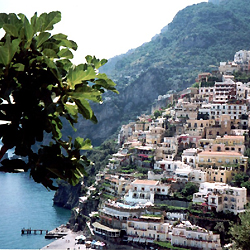 |
| Sorrento: It is still not certain exactly when the town was founded, but Sorrento was, without doubt, already a strategic commercial town for both the Greeks and the Etruscans. Today, Sorrento is a tourist destination of international repute, made all the more popular by a series of ancient traditions including the production of wine, gastronomic products and fine craftsmanship. Oranges, lemons, walnuts, and olives are all grown on the territory Sorrento and a great variety of cheeses are produced here. The town is famous for its wood engraving and lace work, a tradition that dates back to the seventeenth century. Local jewellers make exquisite coral necklaces in various styles and dimensions. All these goods can be found in the little shops tucked away in the alleyways of Sorrento. Sorrento boasts a number of important religious sites such as the archbishopric, the Basilica of Sant' Antonio, the Church of St. Maria del Carmine, the Church of San Francesco d' Assisi, Sorrento Cathedral, and the Monastery of St. Maria delle Grazie. Also well worth visiting are the Correale Museum of Terranova, the Sedile Dominova and the Via della Pietà. |
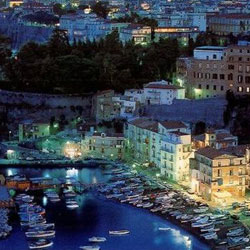 |